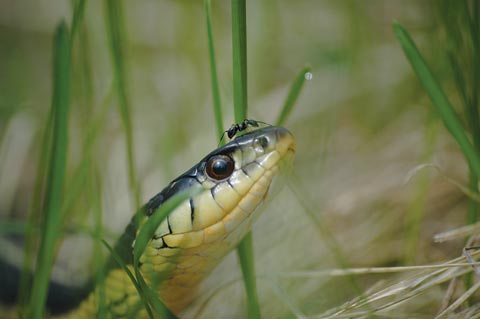
SCIENTIFIC NAME
Thamnophis sirtalis
DESCRIPTION
Garter snakes are typically 60 centimetres long. While their colouring varies greatly, they are generally recognized by a dark body with three light-coloured stripes down their back and sides (usually shades of yellow, red or orange). Some have speckled markings along the lighter coloured stripes and some small populations are all dark with no stripes.
RANGE
Found in the southern portion of the Northwest Territories and all provinces except Newfoundland, the Common Garter Snake is the most widely distributed North American snake. As such there is variation across the country and five subspecies are recognized:
- Puget Sound Gartersnake (T. s. pickeringii) is found on Vancouver Island and the south coastal region of British Columbia
- Valley Gartersnake (T. s. fitchi) is found along the southern and northern coastal regions of British Columbia
- Red-sided Gartersnake (T. s. parietalis) is commonly found from the eastern edge of B.C. to the western edge of Ontario along the Manitoba border and extends northward into the Northwest Territories
- Eastern Gartersnake (T. s. sirtalis) occurs throughout most of Ontario and very western part of Québec along the Ontario border
- Maritime Gartersnake (T. s. pallidulus) occurs throughout southern Québec and the maritime province except for Newfoundland
HABITAT
Garter snakes have adapted to a variety of habitats - forests, fields, wetlands and urban areas. Within these areas, they will inhabit dense foliage close to the ground and areas with leaves, logs and rocks.
DIET
They eat earthworms, frogs, salamanders, fish, slugs, leeches and small mammals.
BEHAVIOUR
undefinedPRIMARY ECOSYSTEM ROLES
Common Garter Snakes eat a variety of animals and therefore play an important role in your garden's ecosystem. In turn, they provide an important food source for many birds and mammals. The red-shouldered hawk, in particular, uses Garter Snakes to help feed their young during the nesting season.
Photo Gallery
- 0
- 1
- 2
